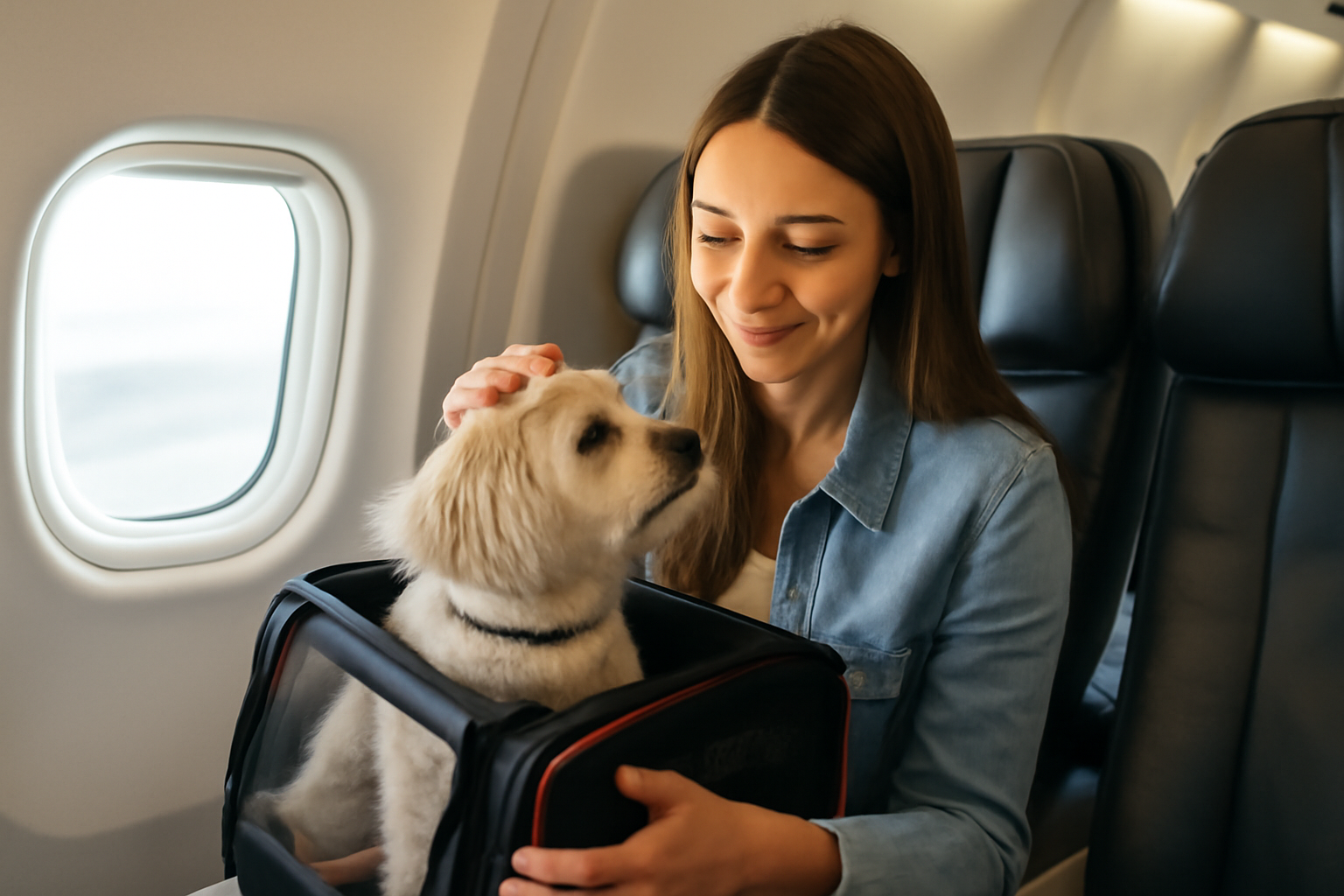Taking your pet with you inside the cabin when traveling internationally is an enjoyable experience but has strict rules that needs to be followed. From every booking rule from airlines to entry laws of different countries, the pet owners need to fully prepare in order to have a smooth trip. This is a comprehensive guide that will show you how to travel with pets in the cabin while in international flights.
Check Airline Pet Policies
Pets that are required to travel in the cabin have certain guidelines depending on the airline company. Some airlines permit only cats and small dogs, but there can be airlines that are more flexible as well. Most also come with a weight requirement, hovering between 15 to 20 pounds, inclusive of the carrier. One has to confirm the permissible size of the container for the pets, the cost of the pet, and whether a given airline accepts pets on the international trip. These policies can also vary depending on seasonality or type of aircraft or country legislation.
Confirm Country-Specific Entry Requirements
Different countries have their own policies when it comes to the importation of pets to the country. Some of them include micro chipping, rabies titer test, or quarantine on arrival among others. Others may have banned the use of certain breeds. Of course, the final information should be obtained from the official government or embassy website of the state you’re going to and to follow all the rules. Failing in a single requirement may ensure your pet will not be allowed to enter, will be quarantined, or will be sent back.
Schedule a Veterinary Appointment for a Health Certificate
All the countries require an international health certificate that has to be issued by a legitimate veterinarian. This is to certify that this animal is healthy and has had proper immunization administered to it as required. Many countries also require that the certificate should be signed by the respective country’s animal health department for instance USDA of United States. Make this appointment ideally within the range of the recommended time which is not more than 10 days before the intended trip. This document should be presented for clearance at the custom office the following points will be checked.
Selecting the Right Carrier on In-Cabin Travel
What is more, your pet will have to remain in a carrier at all times during the flight. It must not exceed the dimensions of the airline’s size requirement and have to fit under the seat in front of you. They should also be well ventilated and water proof so that they do not allow any moisture to penetrate inside them. A soft sided carrier is usually more portable and is more preferred by the airline companies. To give your pet some comfort inside the carrier, place a familiar blanket or toy in it. The carrier needs to be decorated with your personal information like your current address to your destination.
Check In Early And Inform the Airline Company
Some airlines make it a requirement that a certain number of pets are allowed in the cabin for a particular trip, and therefore it would be advisable to book in advance. After that, you need to inform the specific airline with whom you bought your ticket that you would like to include your pet in your list of traveling companions. Some airlines will have a charge for taking your pet in the cabin with them, and some others are likely to ask for some paper works prior to the flight journey. Always make copies of all confirmations and receipts and check all the details at least 72 hours before travelling.
Train Your Pet for Travel
If your pet has never been in a carrier, you should start practicing long before the time you plan to travel. To accustom the pet to the carrier, put their food in the carrying case at first, then wait for a short while before increasing the duration of time the pet spends inside and replicating conditions of travel. This lowers the possibility of your pet getting stressed due to travel and makes the journey less stressful for your pet. That there will be less stress that an animal will be exposed to during the course of the flight if it is calm and well carried along for the trip.
Arrive Early at the Airport
When traveling, one should wake up early in the morning and go to the airport early in the morning. Pets taken into cabin may need further check-in procedures or may be subjected to further searches. Usually, your pet will have to be taken out of the carrier during the TSA check but will have the carrier passed through the X-ray. Some airports have special facilities for your pet; it is advisable you use them before you proceed to your terminal. Make sure that all the documents, such as the health certificate, are secure in your hand luggage.
Keep All Pet Travel Documents Accessible
You will surely be required to present your pet’s documents several times – at check-in, at the security point, and upon arrival. These are the health certificate, vaccines, import permits in case they are needed and evidence of micro chipping. Save these documents in a separate folder and be sure to know where they are kept in case you need them on the move. It can also be the case that paperwork goes missing; this is where having the digital copies can come in handy.
Know What to Expect Upon Arrival
When you arrive to the country you are visiting, you also pass through customs and/or through a pet inspection. Employees may look through the documents of passengers, inspect the health of the pets or, in the worst-case scenario, transfer the passenger to an isolation area if the regulations are not obeyed. Stay polite and kind to the police officers who are on the other side of the television and cameras. Some countries require that the pet owner to submit documents before their arrival and sometimes this may allow the pet to pre-clear before entering the country.
Understand the Rules During the Flight
Some airlines have restrictions on where the pet can be situated in the aircraft; most of them will expect you to have your pet stay in the bag under the seat in front of you during the flight. In this type of plane, you’re often not allowed to take your pet out of the carrier even if it seems uncomfortable or whiny. Some of the items that should be carried include but not limited to absorbent pads if there is likelihood of a spillage, ensure the pet is fed well and exercised well before boarding the flight. A foldable water dish might also come in handy in case your pet feels thirsty mid-flight or after the performance of a flight.
Plan for the Return Journey
This process of taking your pet back home will also have it is regulations that you have to obey. If you come from a high-risk country for rabies or any other diseases, you may be subjected to more scrutiny or quarantined. Even if you are a frequent traveler, you should always check with your country customs and the authorities for importing animals before traveling.
Consider Pet Travel Insurance
While not compulsory, it is prudent to have travel insurance that provides for pets as well. The insurance product options can include incidental vet visits, trip cancellation if pet gets sick, or lost situations. Go through the terms and conditions and see that is the insurance is recognized in the countries you plan to visit.
Make Your Pet’s Comfort a Priority
Animals also get fatigued when on an international trip just like human beings do. As your pet gets to the new location, let him/her take a break and recover from the trip by giving them some water to drink. Supervise them for any sign of distress or discomfort. If planning on being in the location for a long period of time, find a local veterinarian and have the emergency numbers saved.
Final Thoughts
Pet in-cabin international travel can be a cumbersome exercise owing to the fact that it requires planning and a lot of research before the actual journey is undertaken. In order to avoid such problems it is important to familiarize yourselves with the rules of a given airline and that of the country which you are visiting, prepare all the necessary papers for your pet and make it comfortable during the flight. People consider pets as members of the family, so it is not an impossible task to consider them when planning for a trip abroad.





